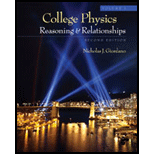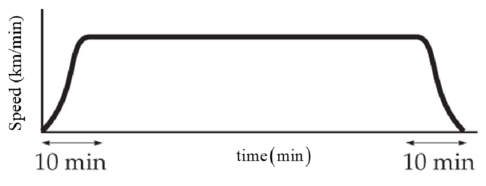
Concept explainers
(a)
The sketch of speed – time graph.
(a)
Answer to Problem 54P
The sketch of speed – time graph of air plane is drawn.
Explanation of Solution
The below figure shows the speed time graph of the airplane.

Airplane was initially at rest on the ground, accelerates quickly and gains its top speed in first 10 minutes and then it travels with constant speed and then while it lands off it decelerates quickly to the ground similar to the acceleration while taking off.
Conclusion:
The sketch of speed – time graph of air plane is drawn.
(b)
The average speed of the trip.
(b)
Answer to Problem 54P
The average speed of the trip is
Explanation of Solution
Write the expression to calculate the average speed.
Here,
Conclusion:
Substitute
Therefore, the average speed of the trip is
(c)
The top speed in the trip
(c)
Answer to Problem 54P
The top speed in the trip is
Explanation of Solution
For the first 10 min and last 10 min that is for a total of 20 min the average speed of the airplane was half the top speed. For the remaining time
Here,
Write the expression to calculate the total distance travelled by the airplane.
Here
Use
Conclusion:
Substitute
Therefore, the a top speed of the trip is
(d)
The average acceleration during first 10 min.
(d)
Answer to Problem 54P
The average acceleration during first 10 min is
Explanation of Solution
Write the expression for average acceleration during first 10 min.
Here,
Conclusion:
Substitute
Therefore, the average acceleration during first 10 min is
(e)
The average acceleration during the central hours of the trip.
(e)
Answer to Problem 54P
The average acceleration during the central hours of the trip is
Explanation of Solution
During the central hours of the trip, the airplane travelled with top speed. Top speed is constant and hence during the central hours of the trip the acceleration was zero.
Conclusion:
Therefore, the average acceleration during the central hours of the trip is
Want to see more full solutions like this?
Chapter 2 Solutions
College Physics, Volume 1
- Ms. Gordon drives to the store to get some milk. She travels at a constant speed of 30.0 mph on her way to the store. While at the store it starts snowing and the roads become treacherous. On the way back she travels at a constant speed of 20.0 mph. She takes the same exact route in each direction. What is her average speed for the entire trip? Don’t count the time that she was in the store. (Hint: the answer is NOT 25.0 mph)arrow_forwardWhile entering a freeway, a car accelerates from rest at a rate of 2.40 m/s for 12.0 s. (a) Draw a sketch of the situation. (b) List the knowns in this problem. (c) How far does the car travel in those 12.0 s? To solve this part, first identify the unknown, and then discuss how you chose the appropriate equation to solve for it. After choosing the equation, show your steps in solving for the unknown, check your units, and discuss whether the answer is reasonable. (d) What is the car’s final velocity? Solve for this unknown in the same manner as in part (c), showing all steps explicitly.arrow_forwardCheetahs can accelerate to a speed of 20.0m/s in 2.50 s and can continue to accelerate to reach a top speed of 27.8 m/s. Assume the acceleration is constant until the top speed is reached and is zero thereafter. Let the +x-direction point in the direction the cheetah runs. Express the cheetah's top speed vtop in miles per hour (mi/h). Vtop= ______________ mi/h Starting from a crouched position, how much time taccel does it take a cheetah to reach its top speed, what distance d does it travel in that time? taccel = ____________ s d=_____________ m If a cheetah sees a rabbit 129.0 m away, how much time ttotal will it take to reach the rabbit, assuming the rabbit does not move and the cheetah starts from rest? ttotal = _________ sarrow_forward
- George, the absent-minded professor, drives his car 5.0 miles due east alonga straight road to the grocery store. Upon arriving there 15 minutes (0.25 h) after he left home, he suddenly realizes he forgot his grocery list. He immediately turns around and heads back towards home. After travelling 6.8 miles due west in 12 minutes (0.20 h), the car runs out of gas. What is his average velocity? Be sure to indicate the directionarrow_forwardAn object is dropped from a roof of a building of height h. During the last second of its descent, it drops a distance h/3. Hint: Let t be the total time of descent. Set up two equations in terms of h, g and t. a) Solve for t, the total time in the air. b) Calculate the height of the building.arrow_forwardQ2 . a) For the displacement equation, s = t2 +t- 5, find the velocity and acceleration equations and plot each equation for the first 5 seconds. b) Compute your average velocity in the following two cases: (a) You walk 73.2 m at a speed of 1.22 m/s and then run 73.2 m at a speed of 3.05 m/s along a straight track. (b) You walk for 1.00 min at a speed of 1.22 m/s and then run for 1.00 min at 3.05 m/s along a straight track. (c) Graph x versus t for both cases and indicate how the average velocity is found on the graph.arrow_forward
- A man went jogging one early morning.He started from his home and arrived at imelda park, 350 meter away, within the First 10 minutes. He continued jogging and passed by the Bartholomew church, another 50 meters away, within 2 Minutes. He followed a straight line path from his home, to the Imelda Park, and to the Bartholomew Church. What was the man's average velocity from his home to the Imelda Park? From Imelda Park to the Bartholomew Church?arrow_forwardAssume that you are driving a car at 10.0 km/h and then you accelerate to 80.0 km/h with an acceleration of 3.50 m/s². How much time will it take until you reach the velocity 80.0 km/h? (Provide you answer in s with two decimal places.) Your Answer:arrow_forwardA turtle and a rabbit engage in a footrace over a distance of 4000m. The rabbit runs 0.500 km and then stops for a 1.5 hr nap. Upon awakening, he remembers the race and runs twice as fast. Finishing the course in a total time of 1.75 hr, the rabbit wins the race. (a) Calculate the average speed of the rabbit in SI units. (b) What was his average speed in SI units before he stopped for a nap? Assume no detours or doubling back.arrow_forward
- The top speed of a Utahraptor is about 9 m/s. How long would it take a Utahraptor to run 1000 m if it accelerates from rest to 9 m/s? Assume acceleration is constant and it reaches its top speed at exactly 1000 m from its starting point. Hint: Look at the kinematic equationsarrow_forwardA high-performance sports car can go from 0 to 100 mph (44.7 m/s) in 7.9s. a) What is the car's average acceleration? b) The same car can come to a complete stop from 30 m/s in about 3.2 s. What is its average acceleration?arrow_forwardA man drives his car down a straight road at 5.2 km at 40 kph at which point he minutes. What is the average velocity of the driver from the time that the car started to the time that the driver arrived at the gas station?arrow_forward
 College PhysicsPhysicsISBN:9781305952300Author:Raymond A. Serway, Chris VuillePublisher:Cengage Learning
College PhysicsPhysicsISBN:9781305952300Author:Raymond A. Serway, Chris VuillePublisher:Cengage Learning University Physics (14th Edition)PhysicsISBN:9780133969290Author:Hugh D. Young, Roger A. FreedmanPublisher:PEARSON
University Physics (14th Edition)PhysicsISBN:9780133969290Author:Hugh D. Young, Roger A. FreedmanPublisher:PEARSON Introduction To Quantum MechanicsPhysicsISBN:9781107189638Author:Griffiths, David J., Schroeter, Darrell F.Publisher:Cambridge University Press
Introduction To Quantum MechanicsPhysicsISBN:9781107189638Author:Griffiths, David J., Schroeter, Darrell F.Publisher:Cambridge University Press Physics for Scientists and EngineersPhysicsISBN:9781337553278Author:Raymond A. Serway, John W. JewettPublisher:Cengage Learning
Physics for Scientists and EngineersPhysicsISBN:9781337553278Author:Raymond A. Serway, John W. JewettPublisher:Cengage Learning Lecture- Tutorials for Introductory AstronomyPhysicsISBN:9780321820464Author:Edward E. Prather, Tim P. Slater, Jeff P. Adams, Gina BrissendenPublisher:Addison-Wesley
Lecture- Tutorials for Introductory AstronomyPhysicsISBN:9780321820464Author:Edward E. Prather, Tim P. Slater, Jeff P. Adams, Gina BrissendenPublisher:Addison-Wesley College Physics: A Strategic Approach (4th Editio...PhysicsISBN:9780134609034Author:Randall D. Knight (Professor Emeritus), Brian Jones, Stuart FieldPublisher:PEARSON
College Physics: A Strategic Approach (4th Editio...PhysicsISBN:9780134609034Author:Randall D. Knight (Professor Emeritus), Brian Jones, Stuart FieldPublisher:PEARSON





